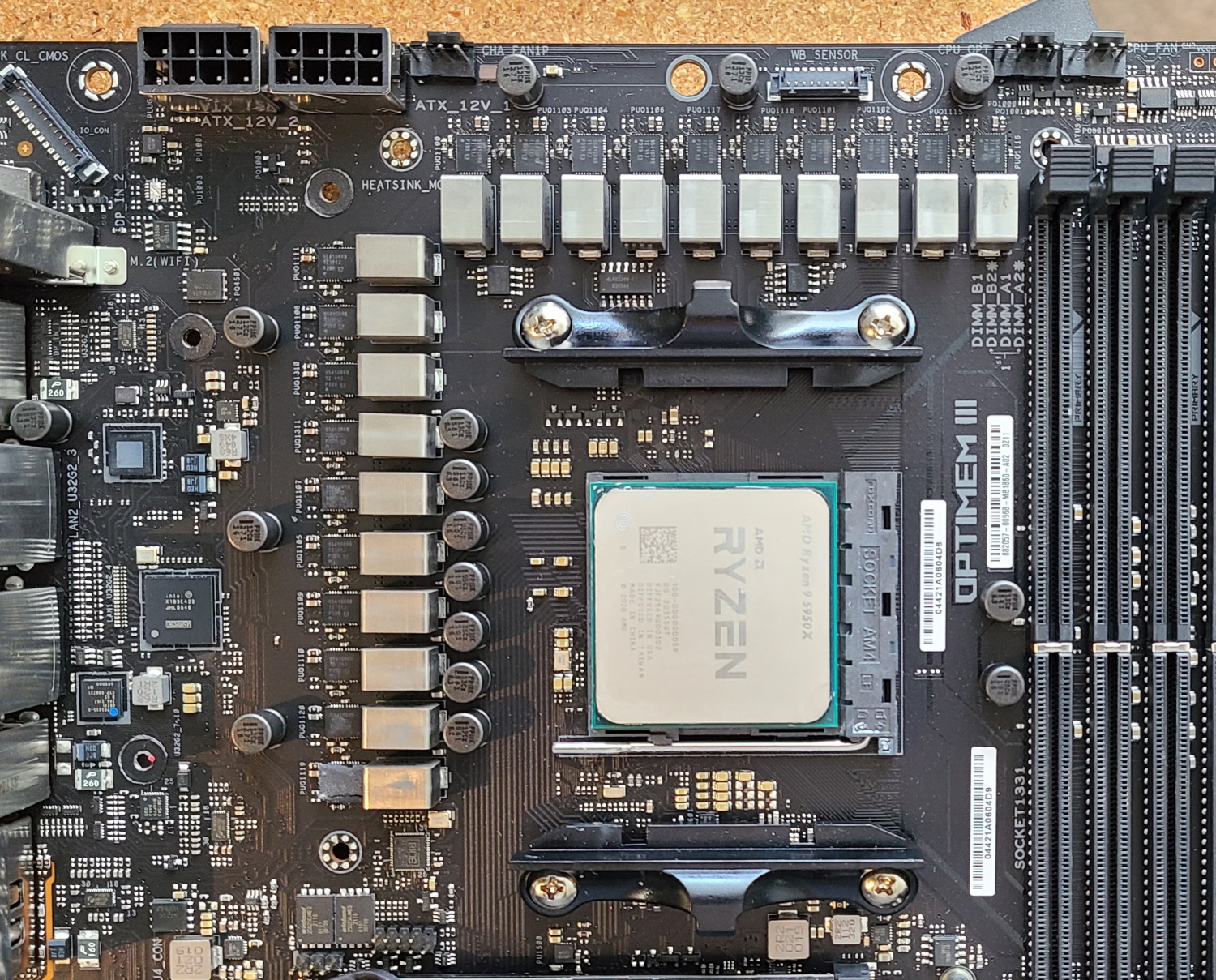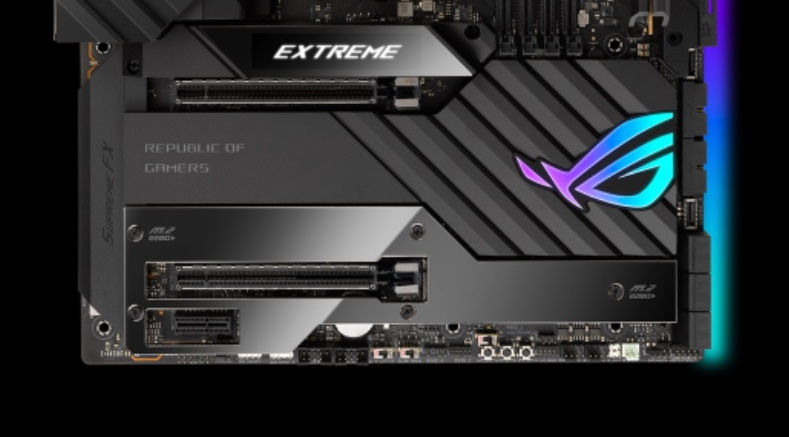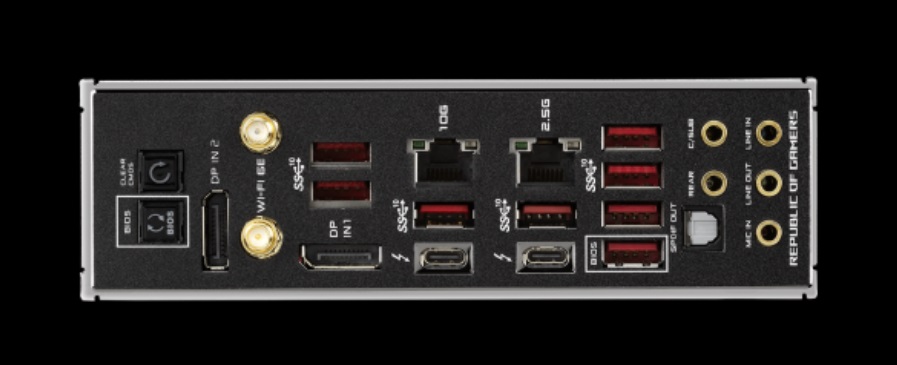Tom's Hardware Verdict
The Asus ROG Crosshair VIII Extreme is an excellent option for those looking for the best that X570 has to offer. The board has top-notch power delivery, comprehensive high-end features and premium looks. If you’re after a flagship-class motherboard for AMD Ryzen and have $799.99, this board is for you.
Pros
- +
+ Robust power delivery
- +
+ Five M.2 slots
- +
+ Thunderbolt 4
- +
+ Comprehensive watercooling abilities
- +
+ 10 GbE and Wi-Fi 6E
Cons
- -
Flagship pricing
- -
Little room to unlatch top PCIe slot
Why you can trust Tom's Hardware
For a couple of generations now on the AMD side, Asus’ flagship motherboard has been the Crosshair Formula. But the company has turned up the dial a bit with its new flagship-class motherboard for the X570 chipset, the ROG Crosshair VIII Extreme. As you might expect, the new Extreme is a feature-laden board that includes a robust VRM, premium audio, ultra-fast network capabilities and USB ports (including Thunderbolt 4), a stylish high-end look and more for $799.99.
Supporting its flagship status, the ROG Crosshair VIII Extreme is an E-ATX size board with oversized heatsinks for the chipset and VRM. There are also large cutouts here for increased airflow and surface area, along with additional shrouds/heatsinks that cover the M.2 slots, making for a great cooling environment. The board can also accommodate up to five M.2 drives, sports two Thunderbolt 4 (Type-C) ports, and has a front-panel USB 3.2 Gen 2x2 port as well.
The Extreme performed well in our testing, excelling in PC Mark 10 tests, while showing average to above-average results in most other tests. Surprisingly, gaming results were slightly lower than average, but not enough to be concerned with. Our overclocking adventures with the Ryzen 9 5950X were met without issue--just set it and forget it. Power use was high during testing, but that’s not surprising considering the kitchen-sink-level features on the board.
Read on as we dig into performance results and dive deep into its other features to see if the ROG Crosshair VIII Extreme deserves a spot on our best AMD X570 Motherboards list.
Specifications - Asus ROG Crosshair VIII Extreme
| Socket | AM4 |
| Chipset | X570 |
| Form Factor | E-ATX |
| Voltage Regulator | 18+2 Phase (90A MOSFETs for Vcore) |
| Video Ports | (2) Thunderbolt 4 (Outputs) |
| Row 5 - Cell 0 | (2) Displayport (Inputs, v1.4) |
| USB Ports | (2) Thunderbolt 4, Type-C (40 Gbps) |
| Row 7 - Cell 0 | (8) USB 3.2 Gen 2, Type-A (10 Gbps) |
| Network Jacks | (1) 10 GbE |
| Row 9 - Cell 0 | (1) 2.5 GbE |
| Audio Jacks | (5) Analog + SPDIF |
| Legacy Ports/Jacks | ✗ |
| Other Ports/Jack | ✗ |
| PCIe x16 | (2) v4.0 (x16, x8/x8) |
| PCIe x8 | ✗ |
| PCIe x4 | ✗ |
| PCIe x1 | (1) v3.0 (x1) |
| CrossFire/SLI | Nvidia 2-Way SLI |
| DIMM slots | (4) DDR4 5000(OC), 128GB Capacity (5000 Series) |
| M.2 slots | (1) PCIe 4.0 x4 / SATA + PCIe (up to 80mm) |
| Row 20 - Cell 0 | (2) PCIe 4.0 x4 / PCIe Only (up to 80mm) |
| Row 21 - Cell 0 | (2) DIMM.2 PCIe 4.0 x4 / SATA (up to 110mm) |
| U.2 Ports | ✗ |
| SATA Ports | (6) SATA3 6 Gbps (RAID 0, 1, and 10) |
| USB Headers | (1) USB v3.2 Gen 2x2 (Type-C) |
| Row 25 - Cell 0 | (1) USB v3.2 Gen 2 |
| Row 26 - Cell 0 | (2) USB v3.2 Gen 1 |
| Row 27 - Cell 0 | (2) USB v2.0 |
| Fan/Pump Headers | (6) 4-Pin |
| RGB Headers | (3) aRGB (3-pin) |
| Row 30 - Cell 0 | (1) RGB (4-pin) |
| Legacy Interfaces | ✗ |
| Other Interfaces | FP-Audio |
| Diagnostics Panel | 2-character debug LED |
| Internal Button/Switch | V_latch, Slow Mode, Safe boot, Retry, BIOS switch, Start and Flex buttons |
| SATA Controllers | ✗ |
| Ethernet Controller(s) | Intel i225 (2.5 GbE) |
| Row 37 - Cell 0 | Aquantia |
| Wi-Fi / Bluetooth | Intel Wi-Fi 6E AX200 (ax, 2.4/5 GHz, 160 MHz) |
| USB Controllers | ASMedia 3242 |
| HD Audio Codec | Supreme FX (Realtek ALC4082) |
| DDL/DTS Connect | ✗ / DTS Sound Unbound |
| Warranty | 3 Years |
As you might expect given its high price and flagship positioning, the ROG Crosshair VIII Extreme comes with a lot of extras. Inside the box is the DIMM.2 add-in card (for installing extra M.2 drives), the ROG Clavis DAC, thermistors, and the ROG Fan controller, among a slew of other, more commonly seen items such as SATA cables and the Wi-Fi antenna. In short, this flagship-class board includes what you need to get started and a whole lot more. Below is a complete list of the included accessories.
- 1-to-3 ARGB splitter cable
- (2) 1-to-4 fan splitter cable
- RGB extension cable
- (3) ROG weave SATA 6G cables
- 3-in-1 Thermistor cables pack
- ROG Fan Controller
- Fan EXT PWR cable
- ARGB input cable
- USB input cable
- ROG Fan Controller 3M Mounting tape
- Fan Controller manual
- ROG DIMM.2 with heatsink
- M.2 pad for ROG DIMM.2
- (2) M.2 screw package for ROG DIMM.2
- ROG Clavis DAC
- Clavis DAC manual
- ASUS Wi-Fi moving antennas
- (2) M.2 SSD screw package(s)
- Q-connector
- ROG key chain
- ROG Graphics card holder
- ROG logo plate stickers
- ROG screwdriver
- ROG stickers
- ROG thank you card
- Installation Media
- USB drive with utilities and drivers
- Documentation
- User manual

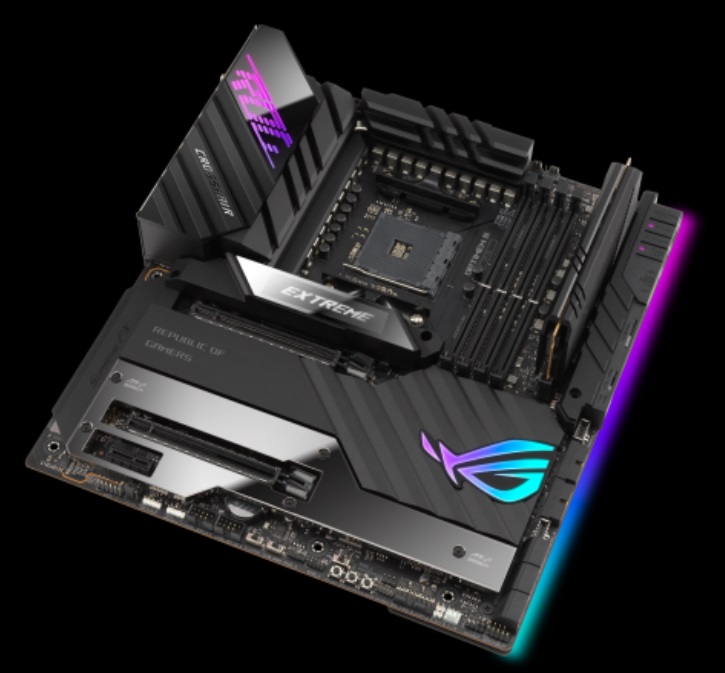
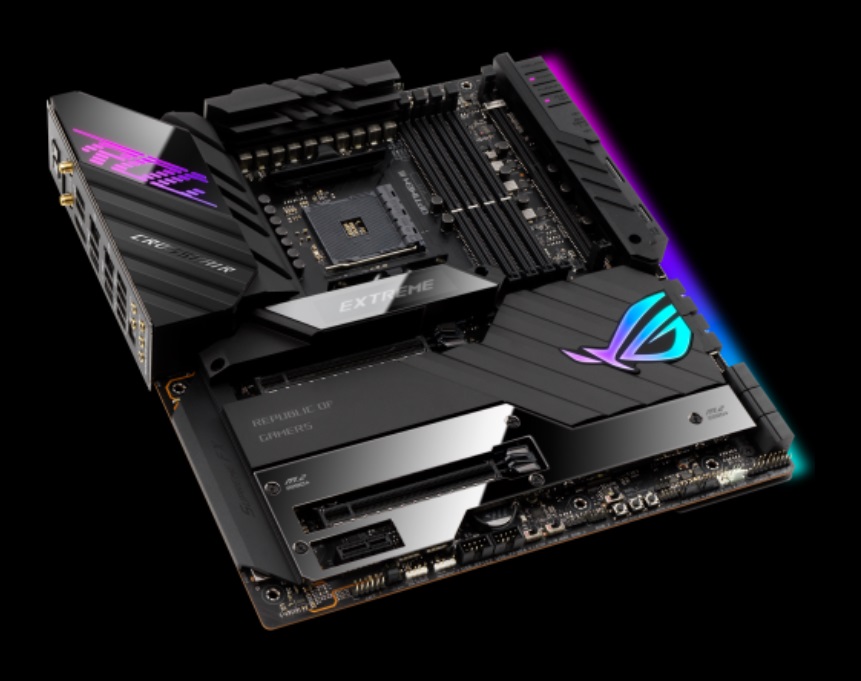
Taking the board out of its and giving it a once-over, one of the first things you’re likely to notice (outside of the weight -- it’s built like a tank and has a backplate) is the high-end appearance. The Crosshair Extreme uses large, deeply grooved heatsinks for the VRMs, with the left heatsink sporting the ROG branding and Crosshair name. The primary M.2 socket hides under a heatsink that sports a customizable 2-inch LiveDash OLED screen that by default displays key system information. Shrouds surround the other M.2 sockets and PCIe slots, with the bottom portion sporting a mirror finish.
If you’re looking for RGB lighting, the Crosshair Extreme doesn’t let you down. The ROG lettering up top and the ROG symbol on the chipset light up from below, along with a long frosted strip that runs along the right edge of the board. The RGBs are saturated and bright, with control handled by Aura Sync software in the company’s Armoury Crate suite.
Get Tom's Hardware's best news and in-depth reviews, straight to your inbox.
Overall, the Crosshair Extreme certainly looks the part of a premium motherboard. The primarily black appearance and integrated RGB lighting ensure the board fits in with most any build theme, while the informative OLED screen is a unique accent to it all.
Focusing on the top half of the board, we get a closer look at the oversized VRM heatsink that reaches out over the rear IO area and sports the ROG branding, lit up with RGBs. The top part of the VRM heatsink connects to the rest via a large heatpipe, sharing the load between them. In all, this is probably one of the heaviest heatsinks I’ve come across on a motherboard. Along with the deep groves and other design elements, there’s a lot of surface area to dissipate heat, and we expect these to work well no matter what you throw at them.
Just above the VRM heatsinks are two reinforced 8-pin EPS connectors to feed power to the CPU. One is required, with the other optional. Just to the right of those is the first (of eight) 4-pin fan headers. All CPU, Chassis, and Radiator headers are Q-fan controlled and support PWM- and DC-controlled devices, while the water pump headers run full speed.
If you’re looking to power your watercooling loop off the headers, you shouldn’t have any issues finding enough power. The CPU and Chassis fans support up to 1A/12W. The two water pump headers support up to 3A/36W, while the two radiator fan headers support up to a whopping 4A/48W. This output is the most I recall seeing on any motherboard to date. If you want to piggyback a few high-powered fans, the radiator headers will happily oblige. Just to the right is the water block sensor header, which measures flow rates with compatible devices. In all, the board has the features needed to run your watercooling loop exclusively from the board.
Continuing right along the top edge, we run across two more fan headers and some integrated voltage read points. The latter reports voltages for Vcore, DRAM, SOC, PLL, and more direct from the board and is a valuable tool to know exactly how much voltage the system delivers (sometimes software is inaccurate).
Below that are four unreinforced DRAM slots, capable of running up to 128GB of DDR4 RAM with speeds listed up to DDR4 5000 (with AMD Ryzen 3000/5000 series processors). As always, your mileage may vary as reaching those speeds requires the right kit and a CPU with an above-average integrated memory controller (IMC). Most builders should stick close to AMD’s sweet spot (DDR4-3600/3733), and this board handles that with ease. Surprisingly, the board set the IF to 1:2 of the memory at DDR4 3600, but the performance wasn’t affected much outside of the higher latency. We set 1:1, and the board handled it without an issue. I would like to have seen this board set that 1:1 ratio by default, but chances are if you’re buying this board, you’re going to be tweaking settings anyway.
To the right of the DRAM slots is the DIMM.2 slot, where you connect the DIMM.2 add-in-card (AIC) supporting two additional M.2 modules (for a total of five). Sourcing its lanes from the chipset, the DIMM.2 card runs both PCIe (v4.0 x4) and SATA-based devices up to 110mm. If you’re looking to run a slew of fast M.2-based storage, the Extreme board has plenty of options.
Finally, along the right edge of the board is a plastic shroud covering a couple of onboard buttons (power and the Flex key), and tastefully hides all of the horizontally oriented headers and plugs in that area. In the right corner is the two-character debug LED, useful for troubleshooting POST issues. There are two more 4-pin fan headers, and the first two RGB LED headers (3-pin ARGB and 4-pin RGB) here as well. Just below that is the 24-pin ATX connector to power the board, along with a supplemental PCIe power connector to allow the Thunderbolt ports to output the full 20V/3A and 60W. Last but not least is another 4-pin fan header. Like the Intel Extreme board(s), I appreciate the horizontally configured headers for better-looking cable management.
Power delivery on the Crosshair VIII Extreme is one of the more capable we’ve seen on this platform. Asus labels it as 18+2, with a whopping 18-phases dedicated to Vcore. Power comes from the 8-pin EPS connector(s) to an Infineon XDPE132G5D 16 channel (X+Y=16) controller, onto the 18 90A Texas Instruments 95410RRB DrMOS MOSFETs, using a teamed power stage design. Asus says this doubles the MOSFET count without adding phase doublers that add to propagation delay, hampering transient response. The 1,620A available is the most we’ve seen on an AMD board in quite a long time. In short, Asus went to the extreme on the VRMs, and they won’t hold back ambient or extreme overclocking.
As we move down to the bottom half of the board, we peel back the shrouds and heatsinks to see what’s going on below. Starting with the audio on the left-hand side, the ROG Supreme FX (Realtek ALC4082) codec hides underneath the heatsink, and a small Faraday cage to reduce EMI. Like most other boards, there’s an audio separation line that runs the length of the board to just below the IO cover, keeping the audio bits isolated from the rest of the board. An ESS SABRE9018Q2C integrated DAC amplifier is wired in, along with several Japanese-made Nichicon audio capacitors. If that doesn’t satisfy your audio needs, the Extreme includes the ROG Clavis digital audio converter (DAC) with an ESS9281 Quad DAC and a built-in amplifier that gives any compatible headset an upgrade. This is about the best audio setup you can get on a motherboard.
Moving into the middle of the board, we’ll start with the PCIe slots. In total, there are three - the two full-length slots use reinforcement (Asus calls this Safeslot), while the x1 slot at the bottom isn’t reinforced. The top slot supports PCIe 4.0 x16, while the second connects via the chipset and supports up to PCIe 4.0 x8 speeds. The slots break down to x8/x8 when running Nvidia 2-Way SLI (and nothing populating M.2_2/3).
As far as M.2 storage, the top socket, M.2_1, is fed from the CPU and supports PCIe 4.0 x4 (64 Gbps) speeds and SATA-based modules up to 80mm. This is also the socket with the largest heatsink and OLED screen sitting on top. M.2_2 and M.2_3 support up to 80mm devices and run PCIe modules only, also up to PCIe 4.0 x4 speeds. There is some lane sharing with the M.2_2 and M.2_3 sockets. If M.2_3 is populated, the second full-length PCIe slot runs at x4 speeds. If both M.2_2 and M.2_3 are populated, the second slot is disabled, and both M.2 sockets run the full x4 speeds.
If the three integrated M.2 slots aren’t enough, the DIMM.2 AIC adds two more M.2 connectors, bringing the total to five. The DIMM.2 card sources its lanes from the chipset and can run two PCIe or SATA-based modules up to 110mm long. You’ll find the six chipset-fed SATA ports located on the right edge are not affected by M.2. The SATA ports support RAID0, 1, 5, and 10.
Also found on the right edge are two front-panel USB 3.2 Type-C ports. The top supports Gen 2x2 (20 Gbps), while the bottom supports Gen 2 (10 Gbps). Wedged between them and are two USB 3.2 Gen1 headers that also use the cable management-friendly horizontal orientation. The six SATA ports mentioned previously are the last features on this right edge.
Across the bottom are several headers, switches, buttons, including RGB, USB and more. Below is a complete list, from left to right:
- Front panel audio
- LN2 mode jumper
- 4-pin RGB and 3-pin aRGB headers
- (2) USB 2.0 headers)
- V_latch and Slow_Mode switches
- (2) Reserved headers
- Safe boot/Retry/BIOS switch buttons
- (2) 4-pin fan/pump headers
- 2-pin Water temperature headers
- Waterflow header
- Speaker
- Front Panel header
Shifting focus around back to the rear IO area, we run into a black, preinstalled IO plate. On the left side, there’s a clear CMOS button and a BIOS button. Next are two DisplayPort ports, both designed to be video input signals and work with the Thunderbolt 4 ports for output. Wi-Fi connections aside (see below), the board includes two ethernet ports, one 2.5 Gbe from Intel (I225-V) and a Marvel Aqtion AQC113CS 10 GbE NIC. There are also two Thunderbolt 4 Type-C ports that support up to 40 Gbps, along with eight USB 3.2 Gen 2 (10 Gbps) ports. Between the ten ports in the rear IO and headers on the board, there’s plenty of fast connectivity available. Last but not least is the 5-plug plus SPDIF audio stack, which has LEDs inside the plugs to identify the port by color.
Next up are the Wi-Fi 6E antenna connections, running to an Intel AX210 Wi-fi 6E card. Asus sent over their flagship ROG Rapture GT-AXE 11000 router and wanted to show off the Wi-Fi 6E ecosystem feature. We’ll address a few features here but leave the details to our review from earlier this year. I can tell you that the router certainly looks the part of a high-end home Wi-Fi box, with RGB lighting on the ROG symbol and the eight Wi-Fi antenna sticking out on all sides.
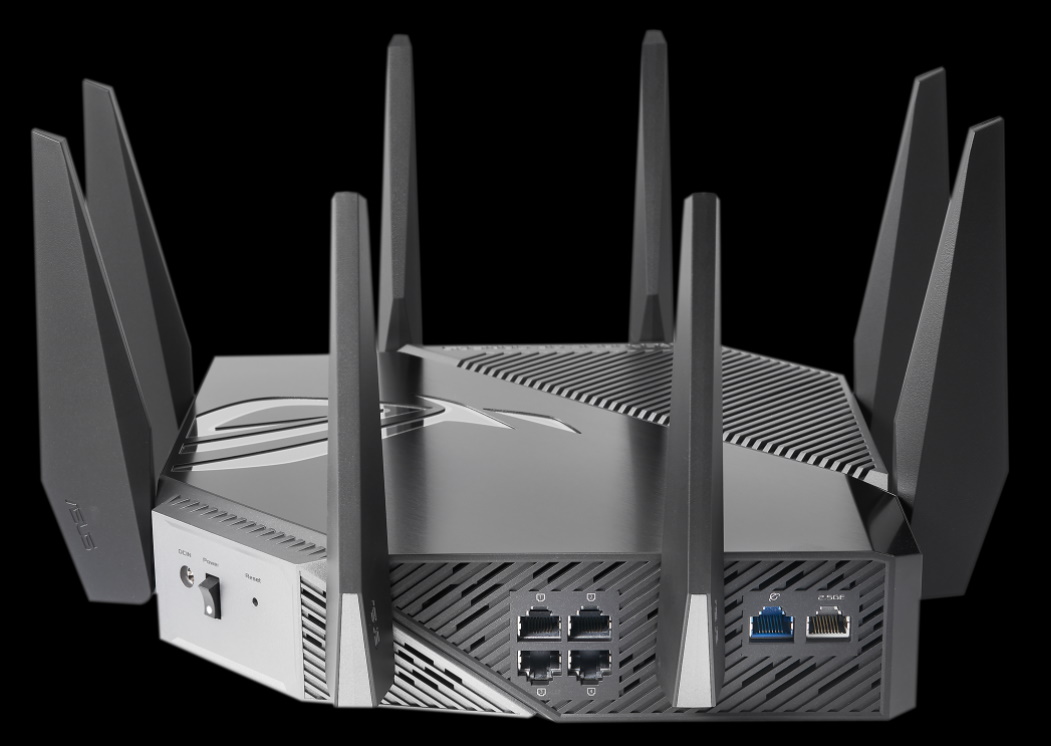

This ultra-fast Wi-Fi 6E Triband router supports up to 1,1000 Mbps speeds, as well as the new 6 GHz frequency band for better performance using wider channels with a higher capacity throughput. The Rapture router also comes with a 2.5 GbE WAN/LAN port, better aligning with the included Wi-Fi 6E. Other features include WAN and Link aggregation, a robust cooling solution for the quad-core processor, and more. As a gamer, I especially like the ability to run both a VPN and an ordinary internet connection simultaneously. This way, you’re able to run a game and connect via a different server and continue to run your internet and chat/stream (for example) on the faster connection.
For $549.99, this router has it all, but to get the most out of it, you’ll need 6E devices (such as this motherboard and recent flagship phones) and fast internet. The speeds at my (home) office are 400 Mpbs down, which is the best available in my neighborhood. That said, performance improvements over mycurrent router were tough to quantify (most connections maxed it out already with Wi-Fi 6), but nearly all Wi-Fi locations showed an increase in signal strength. In order to get the most out of the Wi-Fi 6E, you’ll want an ultra-fast internet connection. But the Asus router handled my small network of 21 attached Wi-Fi devices, including two gaming PC’s and a couple of TV’s for streaming content without a hiccup.
MORE: Best Motherboards
MORE: How To Choose A Motherboard
MORE: All Motherboard Content

Joe Shields is a staff writer at Tom’s Hardware. He reviews motherboards and PC components.
-
Alvar "Miles" Udell Why is it it took an $800 motherboard for ASUS to put more than 2 M.2 slots on it?Reply -
helper800 Reply
Because ASUS wants your money and thats one of the many ways they feature starve their lower end products as motivation to spend 800 on this.Alvar Miles Udell said:Why is it it took an $800 motherboard for ASUS to put more than 2 M.2 slots on it? -
Co BIY $800 to run at most an $800 processor. :whistle: (admiring whistle)Reply
I don't see the value but I know I'm not the target audience.
5 x M.2 sounds great to me although 3x is probably more realistic for my budget. The Add-in-board is very interesting.
LEDs to color code the audio jacks on the rear IO should be replicated for all jacks on the rear IO of even low end boards.
It should cost very little and could probably be done with minimal added cost. Every cheap toy has rear lit LEDs. It would make finding the proper port when working behind or under a desk much easier. Much more useful than 16,000 color RGB strips. -
helper800 Reply
Agreed. Then again people were / are spending 2500-3000 dollars on a 3090 to "play games" on a 1080p monitor so what do we know about value.Co BIY said:$800 to run at most an $800 processor.
I don't see the value but I know I'm not the target audience. -
escksu ReplyAlvar Miles Udell said:Why is it it took an $800 motherboard for ASUS to put more than 2 M.2 slots on it?
There isn't much point in having more than 2 slots. IF you think you can run 5 slots at PCIE 4.0 x 4 speeds, well you can't. -
escksu Take note of the M.2 slots. You cannot run all of them at full PCIE 4.0 speeds. Let me say why:Reply
1. Only the first slot is connected to the CPU directly and the rest is via chipset. Ryzen has total of 24 PCIE 4.0 lanes, 16 for GPU, 4 for M.2 and 4 for chipset.
2. CPU has ONLY 4 x PCIE 4.0 lanes to the chipset. Yes, this means everything that is connected to the chipset goes through these 4 lanes to the CPU including those 4 M.2 slots. So, if you populate all those 4 slots with PCIE 4.0 SSD, you will be severely bottlenecked by the chipset. -
elementalRealms Replyescksu said:Take note of the M.2 slots. You cannot run all of them at full PCIE 4.0 speeds. Let me say why:
1. Only the first slot is connected to the CPU directly and the rest is via chipset. Ryzen has total of 24 PCIE 4.0 lanes, 16 for GPU, 4 for M.2 and 4 for chipset.
2. CPU has ONLY 4 x PCIE 4.0 lanes to the chipset. Yes, this means everything that is connected to the chipset goes through these 4 lanes to the CPU including those 4 M.2 slots. So, if you populate all those 4 slots with PCIE 4.0 SSD, you will be severely bottlenecked by the chipset.
It is all bout adding more storage , not running them all at the same time. No one needs to run 5 SSD storages at the same time reading and writing ... This is not a Server motherboard. You will not be bottlenecked at all in real usage .. you will be accessing one SSD or two maximum at the same time only. Some people miss the reason behind more M2 slots on a gaming motherbard , which is : ADDING MORE STORAGE. -
Upacs ReplyelementalRealms said:It is all bout adding more storage , not running them all at the same time. No one needs to run 5 SSD storages at the same time reading and writing ... This is not a Server motherboard. You will not be bottlenecked at all in real usage .. you will be accessing one SSD or two maximum at the same time only. Some people miss the reason behind more M2 slots on a gaming motherbard , which is : ADDING MORE STORAGE.
you can buy a pcie expansion card to add extra nvme drives if you have to. I bought one a while ago for an old board that doesn't have any... two slots, cost at much as a couple of beers in a bar in town. Asus is clearly pulling a fast one for those with more money than sense, and why not I guess
-
Alvar "Miles" Udell Replyescksu said:There isn't much point in having more than 2 slots. IF you think you can run 5 slots at PCIE 4.0 x 4 speeds, well you can't.
Which is why 3 of them run at 3.0 and is perfectly fine outside of a datacenter, but it's not just about speed, it's about future compatibility. PCIe 4, DDR4, and Ryzen 5000 series CPUs are plenty fast for the next many years. If you're going to spend the money on any X570(S) motherboard these days, which aren't exactly sub $200 like AMD boards used to be, you should want as many M.2 connectors as possible so when cabled SATA finally dies, you have the slots available and don't have to use adapter cards which may kill your GPU PCIe slot speed.
Also with the again falling prices of M.2 drives so that 1TB models are now being found under $100 and even under $90 in some cases, combined with the ease of software RAID in Windows 10, with a minimal to no increase over the same capacity in SATA you have a much tidier case and higher speed.

